
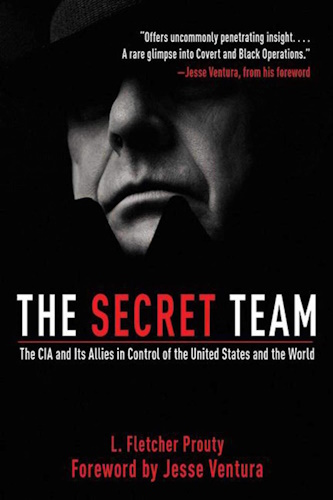
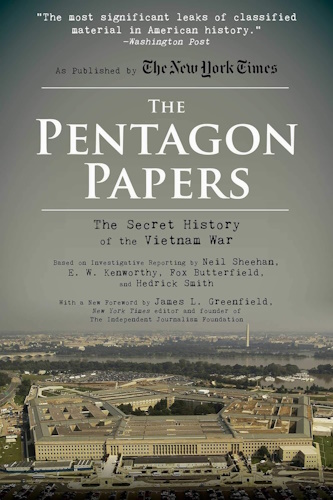

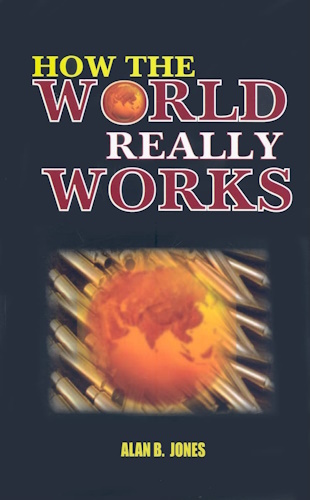

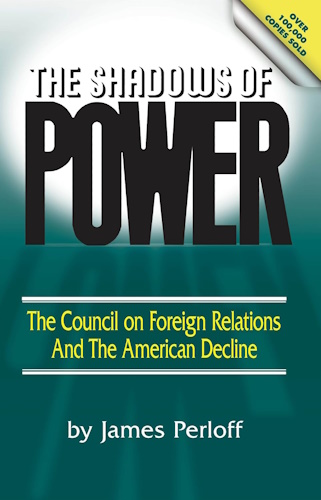

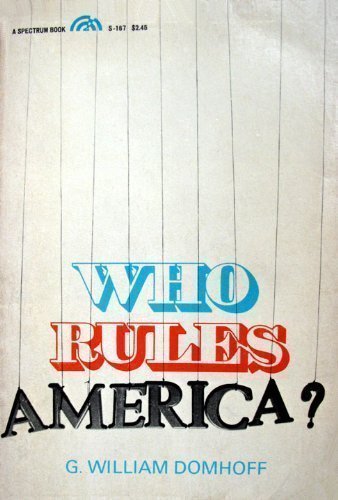

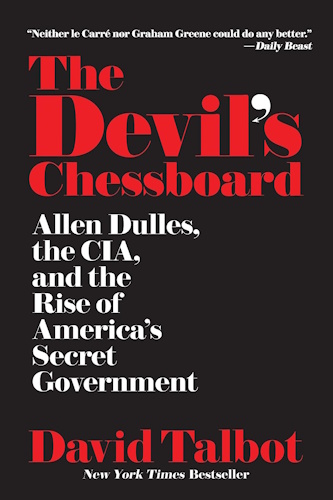
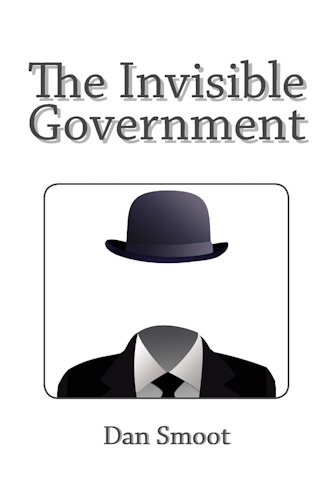

![]()
![]()
PART IV
THE CIA: SOME EXAMPLES
THROUGHOUT THE WORLD
Chapter 23
Five Presidents: "Nightmares We Inherited"
FIVE PRESIDENTS HAVE BEEN RESPONSIBLE FOR AND have had to learn to live with the CIA. A parade of Secretaries of State have seen their power and influence dwindle and be eclipsed almost to extinction by the CIA. Even the Secretary of Defense, who in 1947 was charged with the responsibility for direction of the unified military force of this country, has witnessed the diversion of those forces from their traditional peace time role and their subjugation to the requirements of the special operations activities of the CIA. The conflict in South Vietnam stands as a costly and frightening example of how United States military force can be drawn into an operation in pursuit of the unconventional paramilitary activities of the CIA, and of intangible objectives not in keeping with those of the once proud and historic traditions of military power. The Secretary of Defense retains control over nuclear weapons and their means of delivery. In the context of this book that part of Defense has not become involved in action in support of the ST -- yet.
There have been times when Presidents rode high with the CIA, as with the spectacular escape of the Dalai Lama from beleaguered Tibet, and the encouraging developments in Jordan and other moves to protect and safeguard the oil resources of the Middle East. There have been times of grave embarrassment, as the untimely loss of the spy plane U-2 deep in the heartland of Russia.
John Kennedy rode into office on the shoulders of strong CIA support, re-appointed Allen Dulles and J. Edgar Hoover, and then crashed against the beaches of Cuba with the leaderless Bay of Pigs operational disaster. This episode, coming as it did at the very threshold of his term, awakened him abruptly to the stark realities, gross ineptitude, and sudden dangers of secret operations; and it caused him to study with great care what had gone wrong and where the inherent dangers lay. Supreme Court Justice William O. Douglas recalling a discussion he and Kennedy had about the Bay of Pigs said, "This episode seared him. He had experienced the extreme power that these groups had, these various insidious influences of the CIA and the Pentagon on civilian policy, and I think it raised in his own mind the specter: Can Jack Kennedy, President of the United States, ever be strong enough to really rule these two powerful agencies? I think it had a profound effect . . . it shook him up!"
The eminent, experienced, and wise Supreme Court Justice states the problem precisely when he says, "Can . . . the President of the United States ever be strong enough to really rule these two powerful agencies?" Can any President learn about, comprehend, and then believe what he has learned about this whole covert and complex subject? Can any President see in this vast mechanism, in which there is so much that is untrue and hidden, the heart and core of the real problem? Will any President be prepared to confront this staggering realization when and if he does uncover it? Is this perhaps the great discovery which President Kennedy made, or was about to make? It is not just the CIA and the DOD that are involved. It is also the FBI, the AEC, the DIA, elements of State and of the Executive Office Building, NSA and the hidden pulse of secret power coursing through almost every area of the body politic. It extends beyond into governmental business, the academic world, and certain very influential sectors of the press, radio, TV, papers, magazines, and the publishing business. Before any President can rule this covert automatic control system, he must find out it is there -- he must be aware of the fact it exists -- and he must devise some means to discover its concealed activity.
President Kennedy made a valiant attempt to effect control over this system with his directives, NSAM 55 and 57, as a start. If he had more actively utilized the NSC system, and if he had structured a really strong and effective Operations Coordinating Board or its equivalent, he might have had a chance to grasp control of some segments of this intragovernmental cybernetic machine. As it was, he lacked the administrative experience of Eisenhower, and he did not fully appreciate the power and significance of the NSC/OCB system of effective control. But, as a result of the Bay of Pigs, the inquiry, and the realization by 1963 of how, despite his great efforts, he was still unable to wrest control from and to rule the ST machine, he was beginning to develop an NSC/OCB technique of his own, which by 1965 might have accomplished this task had he lived to perfect it.
Kennedy's battle was not all with the ST. He was going through the same pressures with other groups -- not the least of which was his quixotic contest within the immensely powerful and ruthless professional education establishment and the equally powerful parochial Catholic school hierarchy. For those who have been unable to accept the one-man theory of the Warren Commission report of the Kennedy assassination, there is in evidence more than enough pressure from any one of several of these groups, or their more radical subgroups, to support the germ of the idea that a sinister conspiracy may have arisen from these pressures. For these groups realized that Kennedy was gaining real knowledge, experience, and political power and that he had to be removed from office before winning the inevitable mandate from the U.S. public, which was certain to be his in 1964.
If ever one event had greater influence upon the course of recent history than those shots ringing over Dealey Plaza in Dallas on November 22, 1963, it would be hard to discover what it might be. The man who was to become President in 1969 had been in Dallas only two days before that. Richard Nixon felt the tensions of Dallas in the air in November 1963. He was pierced by the great shock of that staggering event. As the Bay of Pigs had seared John F. Kennedy, the tensions of Dallas seared Nixon. The man who would immediately succeed President Kennedy as President was in a car behind the President. He did not have to read the Warren Commission report, which Allen Dulles and others helped write, to understand the voice of the oracle.
Harry Truman had observed what happened in Dallas from a position once removed. He pondered the significance of that hour, and one month later he wrote:
"For some time I have been disturbed by the way the CIA has been diverted from its original assignment. It has become an operational and at times a policy-making army of the government. . . I never had any thought that when I set up the CIA that it would be injected into peacetime cloak and dagger operations. Some of the complications and embarrassment that I think we have experienced are in part attributable to the fact that this quiet intelligence arm of the President has been so much removed from its intended role that it is being interpreted as a symbol of sinister and mysterious foreign intrigue and a subject for cold war enemy propaganda."
Who knows the thoughts that passed through his mind during those thirty days from November 22 to December 22 in 1963, thoughts that led him to write those powerful and intense words? What "disturbed" him? Who had "diverted" the Agency? How was it "injected into peacetime cloak and dagger operations"? Who did it? And how was the CIA "much removed from its intended role, having become a symbol of sinister and mysterious intrigue"?
Two wise men, much experienced in the terrible pressures of government, Harry S. Truman and William O. Douglas, came up with similar conclusions, one after Kennedy's searing lesson at the Bay of Pigs and the other after his tragic death in Dallas. Both of them saw sinister intrigue and the extreme power of these two groups, the CIA and the Pentagon. Both saw the various insidious influences of the CIA and the Pentagon, and both wondered as Douglas asked, "Can any President ever be strong enough really to rule?"
A third wise, experienced, and tough man raised his hand in Dallas and accepted the awesome responsibilities of the office of President of the United States. While his ears still rang from the sound of those shots, while the murdered President's young wife stood beside him in blood-soaked clothes, while one of his old friends and political cronies lay seriously wounded in the hospital, and while the body of his young predecessor was lifted gently aboard the Presidential aircraft, what thoughts coursed through his mind? Were they by chance similar to those thoughts of Harry Truman and of William Douglas? We may never know.
Then in the following months, when he was engulfed in the affairs of office, it became quite clear that he had come to some hard, earnest, and inevitable decisions: Hold on, keep the temper of the nation below the boiling point, dedicate all action to the restoration of normalcy, and hope for time and divine assistance and guidance to pull through.
Lest anyone wish to raise the suggestion that Lyndon B. Johnson should have made hard, bold, and decisive moves during those fragile and explosive days, let him recall the frightful days in 1968 after the life of Martin Luther King had been snuffed out by another assassin's bullet. The country was very close to real trouble. Law and order was destroyed, and things were out of control in many major cities. The racial riots inspired by the loss of Martin Luther King were one thing. Any violent recrimination over the sudden death of John F. Kennedy could well have been monstrous. The pressures, the deep tragedy, and the popular unrest were all there. Even though the Warren Report itself really satisfies few serious scholars and investigators, it did serve to get this country through a trying time.
Yet not all the answers are to be found this way. Johnson rode on the popular tide that was running first with Kennedy and then later with him. But all the time, those same great pressures were there. The ST machine, always at its most active and insidious best in adversity, surged forward in the post Kennedy void. The record shows that Lyndon Johnson almost never said "No." The only mechanism in existence designed to control the CIA and other members of the ST consisted of the provisions of the National Security Act of 1947, along with other such legislation and directives. It was designed to curtail, to deny, to stop the ClA's inevitable appetite for self-generated activity. There was no curtailment, no denial, and no strong hand to halt its mad rush into Vietnam. Plans that had been directed toward getting out and home by 1965 were suddenly discarded and never mentioned again. Johnson rode the ship throughout the storm, and the team he inherited steered the course based upon data inputs arising from subversive insurgency inspired sources. The wild force of the cult of the gun, resurrected Manifest Destiny, rampant anti-Communism -- ran away with events in Southeast Asia. Even the popular narrative history of the slaughter and extermination of the American Indians and the ruthless Westward Ho as related by Dee Brown inBury My Heart at Wounded Knee, is tame and more believable compared to the waste and devastation brought about by the forces of savagery unleashed upon the helpless people of Indochina.
By the time President Johnson had to make his decision, he already knew too much. Now he saw what Truman saw, what Justice Douglas saw, what Arnold Toynbee saw, and what so many others could see. He had no place to go. His withdrawal in 1968 came as a surprise; but if the LBJ of old had been able to gird himself for battle again, as once he had characteristically been able to do, the next four years would have witnessed the battle of the century, and would have been a bigger surprise than his sudden announcement not to run again. He gave evidence of this in the remaining months of his tenure when, for the first time, he reined in the wild horses and began to put some control on the runaway Indochina conflagration.
Thus the fifth President who has had to live with the CIA and these other forces came upon the scene. There could not have been a man more suited by experience, determination, and background to take over this job. Richard Nixon had lived intimately with the growing power and the growing momentum of the ST during the Eisenhower years. His experience was unmatched. It may have been a handicap. His learning, his training, his beliefs were all tempered by those more established years. His miscalculations at the time of the television debates with John Kennedy serve to underscore that he was not prepared, not aware of the really sinister nature and character of this special adversary, the ST.
He had actively lived through the Eisenhower peace offensive era. He had gone to Russia to meet Krushchev. He had been as shocked and as damaged by the U-2 disaster as Eisenhower, but for different reasons. He had lost his "sure-thing" election to succeed Eisenhower when the shambles of his own crusade-for-peace inheritance turned out to be more a liability than an asset. Furthermore, he had lost some intangible strength when elements of the ST learned that they could hurt him personally as well as at the polls during his campaign against Kennedy.
Above all of these things, however, was his own wealth of experience and his political know-how. Moreover, he was determined to end the war and to give the nation the "lift of a driving dream". Thus, as two years of the Nixon leadership passed, the nation began to evidence real surprise to see that things were not changing as he had promised. The biggest problem was the war. Nixon's strongest promises had been about the war. All other issues paled before that; yet he not only seemed to be no more effective in the face of the war than Johnson had been; he also seemed to espouse the war. The Kennedy-Johnson war had become the Nixon war. What was astounding was that rather than deny this, he actually appeared to accept the mantle. What had happened? As Truman might have said, "How has he been diverted from his original and self-proclaimed assignment. . . What forces a President to change like that?
Have we now witnessed the real significance of the Truman words, of the Douglas words, or the Toynbee words? Is the President, any President, really capable of ruling these forces of insidious influence? Does he rule and command, or is there another power? Can the ST be harnessed? We have one indelible example after the other which seems to say "No." Before his election, Nixon pledged he would end the war. Early in 1971, assessing the outstanding events of his first two years in office, he declared as follows: "We are on the way out [of the war] and we are on the way out in a way that will bring a just peace, the kind of a peace that will discourage that kind of aggression in the future, and that will build, I hope, the foundation for a generation of peace. That is our major achievement in, I think, the foreign policy field."
In the middle of 1972 the war was raging at renewed intensity, equal to any other time despite the token withdrawal of American troops. What has happened to the "driving dream" and the January 1971 proud achievement?
On January 4, 1971, Richard Nixon sat in the library of the White House with four reporters: John Chancellor of NBC, Eric Sevareid of CBS, Nancy Dickerson of PBS, and Howard K. Smith of ABC. It was Howard K. Smith who in a later interview best said what was on the minds of these reporters even at this interview: "Mr. President, l understand that this has been the winter of your discontent." That was the tone of this earlier meeting as they came to discuss his first two years in office. The 1970 midterm elections had not quite been a defeat for his party; but they were no great mandate either. After a rather lengthy and cheerless interview and toward the end of the questions, Nancy Dickerson addressed the President: "Speaking of your campaigns, you made the kickoff address in New Hampshire in 1968 . . . You made a speech how the next President had to give this country the lift of a driving dream . . . Well, as yet, many people have failed to perceive the lift of a driving dream. I wondered if you could articulate that dream for us briefly and tell us how you plan to specifically get it across to the people in the next two years."
The President is always a most polished television personality, and he is characteristically quick, precise, and alert with his answers. But now, toward the end of a trying session and with the weight of the full meaning of that query heavy on his mind, he did a rather uncharacteristic thing. He hesitated, and he looked almost blankly around the room at the four people there with him, and away from the uncompromising eye of the camera. Then he lowered his head and slowly said: "Miss Dickerson, before we can really get a lift of a driving dream, we have to get rid of some of the nightmares we inherited. One of these nightmares is a war without end. We are ending that war . . . But it takes some time to get rid of the nightmares. You can't be having a driving dream when you are in the midst of a nightmare."
Five Presidents have been responsible for and have learned to live with the CIA. Five Presidents at one time or another, under varying conditions and events, have all suffered from this relationship. It can be said that Richard Nixon has come as close as any of them to putting into words the soul-rending, brutal reality of the impact of the power and of the burden that this covert force places upon the mantle of government, when he said, "You can't have a driving dream when you are in the midst of a nightmare." Like a terrible, haunting, terrorizing nightmare, the sinister machine pervades every aspect of the government today -- and affects all of us, our way of life, and the welfare of the entire world.
We have described the ST. We have talked about who it is, what it does, how it operates. But it would be impossible to uncover everything about it and to attribute to it all that it really is. Likewise, it would be wrong to grant to this cybernetic, automatic-control machine more wisdom, more power, more sense than it really possesses. The worst possible mistake would be to overestimate it. It is not just one finite team of individuals. It is a matrix that changes with the gestation of each new operation. It is a sinister device of opportunity and contrivance. What does exist is the mechanism. What exists is the automatic system, much like a nervous system or an electrical system. More properly, what exists is like a giant electronic data processing machine, on the model of Ross Ashby's idea, which has its own power to grow, to reproduce, and to become more insidiously effective and efficient as it operates.
It is a great intragovernmental infrastructure that is fed by inputs from all sources. It can be driven by the faceless, lobbying pressure of a helicopter manufacturer, or of a giant Cam Ranh Bay general contractor. It can be accelerated by the many small pushes of hundreds of thousands of career military personnel -- uniformed and civilian -- who see higher rank and higher retirement pay as a goal worth seeking. It can be suddenly activated by almost any "counterinsurgency" area or similar "hot button" initiator.
This great machine has been constructed by such able men as "Wild Bill" Donovan, Clark Clifford, Walter Beedle Smith, Allen Dulles, Maxwell Taylor, McGeorge Bundy, and many others, who have guided and molded it into the runaway giant that it is today. It is big business, big government, big money, big pressure, and headless -- all operating in self-centered, utterly self-serving security and secrecy. As C. P. Snow has said, "The euphoria of secrecy goes to the head." And as Allen Dulles has said, perhaps in a slightly different context, this is really the craft of intelligence.
For all its fabrication and apparent unreality, especially in this open society, the ST machine does have a central soul or brain. . . or perhaps. . . holy spirit. It is the evidence of a form of new religion. It has its secrets. It has its divine and unquestioned rights and obligations. It has self-righteous power over life and death. It does not believe in anything. It does not value anything. It is utterly ruthless. Its greatest motivating force and drive is entirely undefined, because it moves by pressure. It reacts. It is therefore blind, meaningless, senseless. It will do anything in the name of anti-Communism. Yet in its greatest anti-Communist war it sees no inconsistency in the killing of one of its most anti-Communist creations -- Ngo Dinh Diem. In its zeal to rid the Caribbean of Communism, it leaps at the chance to rid the Dominican Republic of Latin America's strongest non-Communist, Rafael Trujillo. Any person or groups that know how to get to this infrastructure, who have the clearances, who have the need-to-know, can make an input into this ST, and as long as the desired action is anti-Communist, the system will operate.
As Kennedy saw, as Johnson may have seen, as Nixon's "nightmare" may suggest, there is but one way to control this massive ST structure. It must be uncovered. It must be made known. It must be exposed to the light. And then it must be told No. To be effective, this means that Congress must cut its money off, not only at the central source, but at all the hidden nerve centers.
Before it is too late, we Americans must realize that this great cancer exists. We must expose it for pro-American reasons; not as a work of anti-Communism. We have been subjected to so many anti-American and pro-Communist notions all in the name of anti-Communism, that words and facts almost elude us. We must look at all actions -- political, social, governmental, and international -- in terms of their being pro-American. There is such a world of difference between a truly pro-American positive action, and an anti-Communist passive, or reactive, operation.
It is not pro-American to pay barbaric tribute before the shrine of anti-Communism in Southeast Asia by sacrificing fifty-five thousand young men there. Neither is it pro-American to pay tribute in the amount of hundreds of billions of dollars before false altars of savagery there. There may be some argument, some slight argument, about such central effort being anti-Communist. We have been so brainwashed about the meaning of anti-Communism for twenty-five years that we may have forgotten what it really means. To be anti-Communist should mean that an action does have some effect upon real Communists and Communism; certainly the loss of not one Russian in an anti-Communist war can hardly be hurting the Russians one bit. But regardless of this semantic issue, the fact is that what had been going on in Indochina is not pro-American, and that is what matters the most.
Thus this ST must be exposed, bared, and silenced. Then a new and better way of life must be created. We must end the philosophy of Defense. The alternative is not simply Offense, either. The real alternative is the requirement for a sensible strategic concept to meet American needs, not to counter imagined and suspected Communist threats. We must end the policy of "Re-action" in favor of planned action and positive diplomacy. We must end the exploitation of secret intelligence by clandestine operations.
The first twenty-five years of the CIA have given solid evidence of how important the ideas of those legislators in 1947 were. The CIA should be, must be, the "quiet intelligence arm of the President". Not his nightmare. The CIA should be limited to the function of intelligence -- and not a bit more.












-
Urantia Book, 44:0.11 - The Celestial Artisans
Never in your long ascendancy will you lose the power to recognize your associates of former existences. Always, as you ascend inward in the scale of life, will you retain the ability to recognize and fraternize with the fellow beings of your previous and lower levels of experience. Each new translation or resurrection will add one more group of spirit beings to your vision range without in the least depriving you of the ability to recognize your friends and fellows of former estates.
-
Princess Bride 1987 Wallace Shawn (Vizzini) and Mandy Patinkin (Inigo Montoya)
Vizzini: HE DIDN'T FALL? INCONCEIVABLE.
Inigo Montoya: You keep using that word. I do not think it means what you think it means. -
Urantia Book, 117:4.14 - The Finite God
And here is mystery: The more closely man approaches God through love, the greater the reality -- actuality -- of that man. The more man withdraws from God, the more nearly he approaches nonreality -- cessation of existence. When man consecrates his will to the doing of the Father's will, when man gives God all that he has, then does God make that man more than he is.
-
Urantia Book, 167:7.4 - The Talk About Angels
"And do you not remember that I said to you once before that, if you had your spiritual eyes anointed, you would then see the heavens opened and behold the angels of God ascending and descending? It is by the ministry of the angels that one world may be kept in touch with other worlds, for have I not repeatedly told you that I have other sheep not of this fold?"
-
Urantia Book, Foreword - 0:12.12 - The Trinities
But we know that there dwells within the human mind a fragment of God, and that there sojourns with the human soul the Spirit of Truth; and we further know that these spirit forces conspire to enable material man to grasp the reality of spiritual values and to comprehend the philosophy of universe meanings. But even more certainly we know that these spirits of the Divine Presence are able to assist man in the spiritual appropriation of all truth contributory to the enhancement of the ever-progressing reality of personal religious experience—God-consciousness.
-
Urantia Book, 1:4.3 - The Mystery Of God
When you are through down here, when your course has been run in temporary form on earth, when your trial trip in the flesh is finished, when the dust that composes the mortal tabernacle "returns to the earth whence it came"; then, it is revealed, the indwelling "Spirit shall return to God who gave it." There sojourns within each moral being of this planet a fragment of God, a part and parcel of divinity. It is not yet yours by right of possession, but it is designedly intended to be one with you if you survive the mortal existence.
-
Urantia Book, 1:4.1 - The Mystery Of God
And the greatest of all the unfathomable mysteries of God is the phenomenon of the divine indwelling of mortal minds. The manner in which the Universal Father sojourns with the creatures of time is the most profound of all universe mysteries; the divine presence in the mind of man is the mystery of mysteries.
-
Urantia Book, 1:4.6 - The Mystery Of God
To every spirit being and to every mortal creature in every sphere and on every world of the universe of universes, the Universal Father reveals all of his gracious and divine self that can be discerned or comprehended by such spirit beings and by such mortal creatures. God is no respecter of persons, either spiritual or material. The divine presence which any child of the universe enjoys at any given moment is limited only by the capacity of such a creature to receive and to discern the spirit actualities of the supermaterial world.
-
Urantia Book, 11:0.1 - The Eternal Isle Of Paradise
Paradise is the eternal center of the universe of universes and the abiding place of the Universal Father, the Eternal Son, the Infinite Spirit, and their divine co-ordinates and associates. This central Isle is the most gigantic organized body of cosmic reality in all the master universe. Paradise is a material sphere as well as a spiritual abode. All of the intelligent creation of the Universal Father is domiciled on material abodes; hence must the absolute controlling center also be material, literal. And again it should be reiterated that spirit things and spiritual beings are real.
-
Urantia Book, 50:6.4 - Planetary Culture
Culture presupposes quality of mind; culture cannot be enhanced unless mind is elevated. Superior intellect will seek a noble culture and find some way to attain such a goal. Inferior minds will spurn the highest culture even when presented to them ready-made.
-
Urantia Book, 54:1.6 - True And False Liberty
True liberty is the associate of genuine self-respect; false liberty is the consort of self-admiration. True liberty is the fruit of self-control; false liberty, the assumption of self-assertion. Self-control leads to altruistic service; self-admiration tends towards the exploitation of others for the selfish aggrandizement of such a mistaken individual as is willing to sacrifice righteous attainment for the sake of possessing unjust power over his fellow beings.
-
Urantia Book, 54:1.9 - True And False Liberty
How dare the self-willed creature encroach upon the rights of his fellows in the name of personal liberty when the Supreme Rulers of the universe stand back in merciful respect for these prerogatives of will and potentials of personality! No being, in the exercise of his supposed personal liberty, has a right to deprive any other being of those privileges of existence conferred by the Creators and duly respected by all their loyal associates, subordinates, and subjects.
-
Urantia Book, 54:1.8 - True And False Liberty
There is no error greater than that species of self-deception which leads intelligent beings to crave the exercise of power over other beings for the purpose of depriving these persons of their natural liberties. The golden rule of human fairness cries out against all such fraud, unfairness, selfishness, and unrighteousness.



